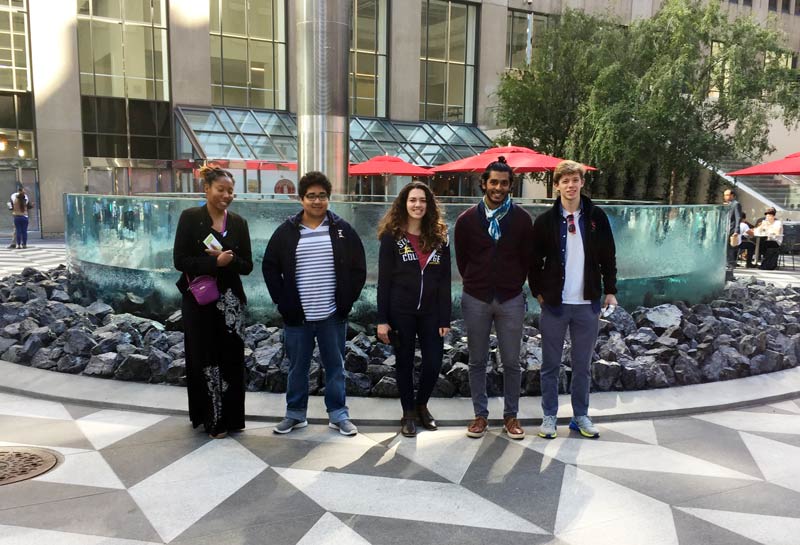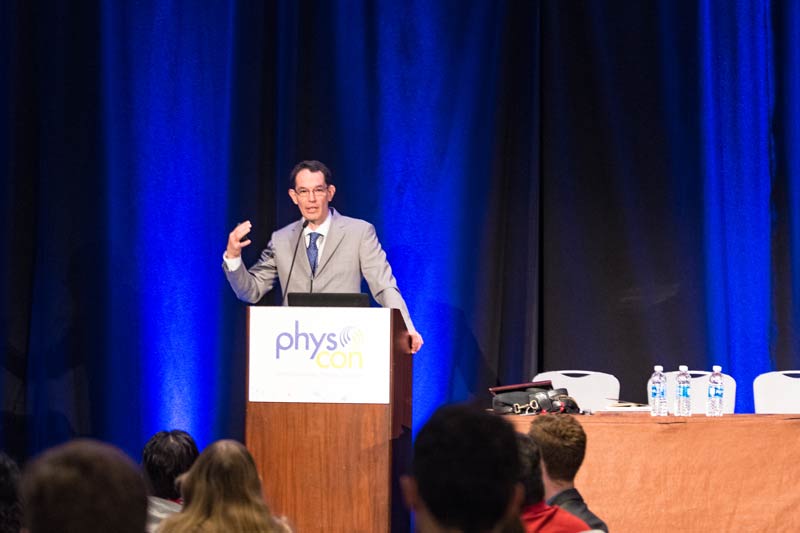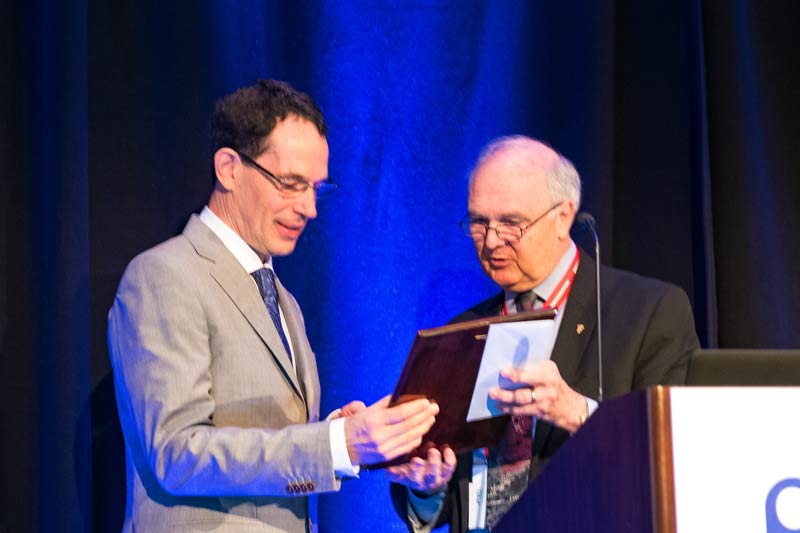Sigma Pi Sigma Physics Congress (PhysCon)
November 3, 2016 to November 5, 2016
San Francisco, CA
Meeting host: By:Caroline Goyco, Arvind Srinivasan, and Noah Walsh
SPS Chapter:

In November 2016, St. Mary’s College of Maryland sent five undergraduate students and one faculty member to the Quadrennial Physics Congress held in San Francisco, California.
Among the many tours, workshops, and talks, one talk that left a lasting impression on senior Tommie Day was the talk by Dr. Neil Turok. A running theme throughout the conference was increasing diversity within the physics community and making the community a more inviting space.
Dr. Turok’s talk fit well with this theme. Dr. Turok was born in South Africa to political activist parents. His parents were very involved in the fight against apartheid, and he recalled being bullied as a young child for his ethnically diverse friend group and the outspoken activist reputation of his parents. Both of his parents spent time in jail for protesting apartheid. Soon after, he and his parents fled the country to Tanzania, and at 10 years of age he moved to London.
After finishing his schooling, he started working for Princeton, a job he was very excited for at first. However, after working there, he noticed that “the professors were all white males, the administrators were all white women, and the maintenance staff were all black men.” Disgusted, he argued that “progress could not exist in such a racist, sexist hierarchy” and left the faculty.

Recently, Dr. Turok has started an institution of higher education in South Africa. Founded in 2003, the African Institute for Mathematical Sciences (AIMS) is a premier postgraduate center that seeks to promote mathematics and science in the African continent. Dr. Turok is also a director at the Perimeter Institute for Theoretical Physics, a highly competitive graduate and postgraduate program that consistently produces innovative and brilliant theoretical thinkers. A consistent theme throughout his talks is that physics must not only provide first-rate training and education to students, but must also engage in positive outreach to communities, governments, and policy makers. This is one of the core aims of the Perimeter Institute as well.
A contemporary of Stephen Hawking, Dr. Turok believes the universe is simpler than we think and views multiverse theories as “utterly confused.” In an interview before the plenary talk, we asked Dr. Turok about the future of physics, specifically with regards to our knowledge of the universe. In light of recent achievements, Dr. Turok’s answer wasn’t all that surprising; he said:
“This is really an exciting time in physics, and the reason is all observations. In the last four years, we’ve had the LHC discovery of the Higgs Boson—spectacular—50 years after it was predicted, Planck satellite mapping of the whole universe, and then we’ve recently had LIGO telescope seeing black holes colliding. These are unbelievable observations.”
In our final question before the talk, we asked Dr. Turok if he could sum up what we should take away from his talk, and he responded succinctly with “courage!” We think this is a message that resonated through the entire Congress. We find courage in knowing we have peers and friends within our field who will support our accomplishments and fight for fairness and equality within the physics community. We find courage in seeing the brilliant minds that came before us, astounding plenary speakers that take the time to speak to the next generation of undergraduate students entering the physics community. And we find courage in the support systems of our own departments and the faculty that encourage our growth and participation in the wider physics community.
We left the conference energized, encouraged by the realization that there were other peers and mentors who cared about the issues minority and female students face when studying physics. We found a group of like-minded students (over 1000 undergraduates!) that wanted to see change, growth, and acceptance and were willing to fight for those ideals.

Dr. Turok’s plenary was not the only part of PhysCon we enjoyed. The rest of the conference was a whirl of outstanding plenary talks, undergraduate research presentations, networking events, and workshops with peers. We also visited nearby Stanford for graduate program tours, and members of our college got to attend the Google X tour and the SLAC tour. Junior Caroline Goyco enjoyed seeing the LIDAR camera used in Google’s self-driving car.
Google X is Google’s “moonshot factory.” This means that they work on innovative and creative solutions to really tough real-world problems. Goyco said she connected the way engineers and scientists in Google X problem-solve to the work she does in class, describing how they “work from first principles to test if an idea may be sound.” Outlandish solutions aren’t rejected out of hand or because they seem difficult, but rather only if they actually violate the laws of physics. Sophomore Noah Walsh also attended the Google X tour, where he saw their emerging project “Loon,” an innovative idea to use weather balloons to bring WiFi to areas around the world without internet access.
We were also amazed to see the breadth and variety of interests and research projects that our fellow students are involved in, and enjoyed the other plenary talks as well.
Walsh enjoyed the talk by Dr. Eric Cornell the most “because his research was fascinating and the way he presented it allowed undergraduates to better understand the material.” Senior Arvind Srinivasan most enjoyed Dr. Cornell’s talk as well because “it related research [he] had done to new physics.”
Goyco felt very encouraged by Jocelyn Bell Burnell’s opening plenary and also enjoyed Jim Gates’ plenary where he explained the structure of the universe in an understandable way. We have returned to St. Mary’s College of Maryland excited about physics and our future roles in advancing physics in many different fields. If you have the chance to attend PhysCon in the future: do it! You won’t regret attending.